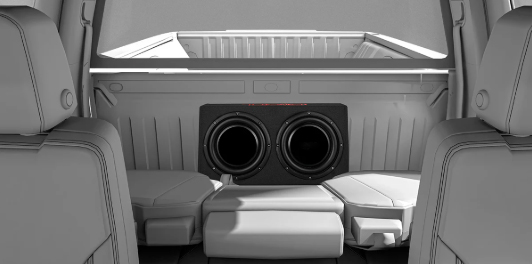Technology has grown and people’s expectations for the driving experience have risen, leading to the audio system in the car playing a large role in that experience. For car owners that value sound quality, too often the bass of an ordinary car audio system does not meet their standards. As a result, more and more car owners are beginning to add subwoofers to their trucks and other vehicles.
In addition to increasing the low frequency response and adding the bone-shaking effects of the music, a subwoofer helps to make the total audio experience much more balanced.
So why is installing a subwoofer in your truck a worthwhile investment? How do you choose the right subwoofer and achieve the best acoustics? These questions are worth exploring in depth.
Subwoofers Make a Difference
Firstly, the main function of a subwoofer is to enhance low frequency response. Bass is a non-negligible part of the audio system, which not only affects the layering of music, but also plays a crucial role in the immersion of multimedia content such as films and games. General car audio systems can only provide a clear output of medium and high frequencies, but often fail in the performance of low frequencies. Even the best in-car speakers are difficult to effectively reproduce the shocking bass effect. The addition of a subwoofer is designed to make up for this deficiency.
For car owners who like rock, electronic dance music (EDM) or hip-hop, a subwoofer can bring out the low-frequency parts of such music. Whether it’s the subdued bass drums or the vibration of low-frequency percussion instruments, the subwoofer provides a more realistic, deeper sound. Moreover, the subwoofer is not only an enhancement tool for the acoustics, it can also bring a richer driving experience to the car owner. Powerful bass can not only be perceived in the ears, but also transmitted to the whole body through the vibration of the cabin, and this vibration can almost make the driver feel at one with the music.
Why choose a subwoofer?
The reason for installing a subwoofer for the truck is, first of all, to enhance the low-frequency performance, making the overall sound effect more full. In the driving process, owners often hear the low-frequency sound will often seem thin or lack of strength. By adding a subwoofer, the low-frequency part will become deeper and more shocking, which not only enhances the sound quality, but also improves the balance of the audio system. Especially when driving at high speeds, the vehicle’s external noise and wind noise may have a certain impact on the sound quality, while the subwoofer can provide strong low-frequency compensation, making the car’s audio performance more stable.
Secondly, the subwoofer can decompressed the various pieces of the car audio system. Without a subwoofer, in-car speakers have to do the mid-range audio playback and also the low-frequency playback. They often get overloaded in the lower frequencies. By allocating the low-frequency part of the spectrum to the subwoofer, you allow the other speakers to play the middle and upper frequencies and the overall sound quality should, of course, improve considerably. Ultimately, a subwoofer can improve the overall experience. For truck owners that typically spend a lot of time driving or traveling in the car, having a subwoofer installed in your car can enhance the listening experience even further. The subwoofer enriches the music by providing a sensation of vibration to the music and often reveals the details of each and every song.
How do you determine the correct subwoofer?
Choosing a subwoofer for your truck starts with the truck’s space and mounting location. Trucks generally have more space than a sedan or hatchback; therefore, I generally like to think you have a little more leeway with subwoofers. However, you will certainly need to factor in the space dimensions and how you used the truck to determine if the subwoofer will occupy too much space and limit your ability to use the vehicle normally.
Generally speaking, common subwoofer sizes are 10 inches, 12 inches and 15 inches, etc. Owners can choose the right size according to their needs and the space situation of the truck.
The power of the subwoofer is also an important indicator when choosing. Different subwoofers have different power ranges, and owners need to choose according to the power demand of their audio system. Usually, a subwoofer with higher power can provide stronger low-frequency response, but it also needs to be equipped with an amplifier of corresponding power. When choosing the power, attention should also be paid to matching with the on-board amplifier to avoid sound quality distortion or equipment damage due to power mismatch.
Impedance is also important. The impedance of a subwoofer is typically 2O, 4O, or 8O, and you should choose the equivalent impedance matched with the amplifier in the car audio system. If you choose a mismatched impedance, an amplifier may become overloaded or even fail. Sensitivity is yet another parameter to rear more attention to when picking a subwoofer. Higher sensitivity means a subwoofer produces greater volume for the same amount of power, where lower sensitivity subwoofers will usually require higher amounts of power to produce equivalent volume levels.
Lastly, maybe the material used to make a subwoofer is actually one of the most direct ways to affect the sound quality. The most common subwoofer materials are pulp, polymer, aluminium alloy, and carbon fiber. Each material will have their own sound quality features, and car owners can choose the appropriate material according to their sound quality requirements and price range.
Precautions for installing subwoofer

Installing a subwoofer is not really complicated, but your initial task will be to identify a suitable position for installation. In most vehicles, the most common locations for installation is usually either the back of the seat, the truck compartment, or under a seat behind the driver or passenger. So the driver will have to pick an installation location that will fit sufficiently in the space provided with little impact on occupant space; while also providing the best sound quality possible according to the space in the vehicle and the owner’s needs.
When installing, you will need to ensure that the subwoofer is compatible with the rest of the car audio system, using the correct wiring and installation techniques; that may also effect the sound, improper installation can affect the sound quality of the audio products or improper setups can effect the sound quality too. If the owner is installing the system to the proper specifications, there should not be any problems with effecting sound quality.
When installing a subwoofer, it will be necessary to properly connect the power, signal and earth terminals to avoid electrical problems or malfunctions. You will need to pay attention to installation directions including the needs for power requirements or signal input connection options to enhance the sound quality of the audio system.
In summary, installing a subwoofer for your truck is a good investment not only to improve sound quality, but also to improve the way you experience driving. Installing a subwoofer will greatly improve low frequency performance of the vehicles system, making one’s drive much more pleasant and comfortable. When choosing a subwoofer, a truck owner looking to enhance their system will need to reflect intensely on the subwoofer size, power, impedance, sensitivity, materials and other subwoofer factors to ensure they purchase a suitable product. Likewise, proper installation and debugging will be paramount to the success of the subwoofer too.
Through reasonable matching and scientific installation, the performance of the truck’s audio system will reach a new height, bringing the owner a more shocking audio experience.
